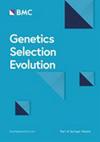调查驯化后扩散对现代欧洲、非洲和亚洲山羊多样性的影响
IF 3.1
1区 农林科学
Q1 AGRICULTURE, DAIRY & ANIMAL SCIENCE
引用次数: 0
摘要
山羊是在距今约 10,000 年(YBP)前的新月沃地被驯化的,随后在欧亚大陆和非洲传播。随着与早期牲畜管理地区的距离越来越远,这种扩散预计会产生遗传多样性下降的梯度。以前的研究曾报道过欧洲山羊种群中存在这种遗传梯度,但这些研究都是基于数量有限的微卫星标记。在这里,我们分析了 AdaptMap 项目和其他研究产生的数据。更具体地说,我们使用了 1077 只欧洲山羊、1187 只非洲山羊和 617 只亚洲山羊(分别属于 38、43 和 22 个不同品种)的地理坐标以及观察到的杂合度(Ho)和预期杂合度(He)的估计值,以找出遗传多样性是否与与伊朗西部新石器时代定居点 Ganj Dareh 的距离显著相关。主成分和 ADMIXTURE 分析表明,欧洲品种的地区分化并不完全,但代表北欧和英爱群岛的两个基因群与其他欧洲种群有明显的分化。在非洲犬种中,我们观察到五个主要群落:(1) 北非,(2) 西非,(3) 东非,(4) 南非和 (5) 马达加斯加。在亚洲品种方面,我们观察到了西亚、南亚和东亚三个差异明显的群体。在欧洲和亚洲山羊中,Ho 和 He 与 Ganj Dareh 的距离之间没有发现显著相关的有力证据。相反,在非洲品种中,我们发现了明显的多样性梯度,这种梯度随着与甘杰达雷的距离而降低。在非洲而非欧洲或亚洲的山羊品种中发现了与甘杰达雷距离相关的遗传系,这可能反映了这三大洲山羊种群在驯化后的扩散过程和随后的迁徙过程中存在的差异。本文章由计算机程序翻译,如有差异,请以英文原文为准。
Investigating the footprint of post-domestication dispersal on the diversity of modern European, African and Asian goats
Goats were domesticated in the Fertile Crescent about 10,000 years before present (YBP) and subsequently spread across Eurasia and Africa. This dispersal is expected to generate a gradient of declining genetic diversity with increasing distance from the areas of early livestock management. Previous studies have reported the existence of such genetic cline in European goat populations, but they were based on a limited number of microsatellite markers. Here, we have analyzed data generated by the AdaptMap project and other studies. More specifically, we have used the geographic coordinates and estimates of the observed (Ho) and expected (He) heterozygosities of 1077 European, 1187 African and 617 Asian goats belonging to 38, 43 and 22 different breeds, respectively, to find out whether genetic diversity and distance to Ganj Dareh, a Neolithic settlement in western Iran for which evidence of an early management of domestic goats has been obtained, are significantly correlated. Principal component and ADMIXTURE analyses revealed an incomplete regional differentiation of European breeds, but two genetic clusters representing Northern Europe and the British-Irish Isles were remarkably differentiated from the remaining European populations. In African breeds, we observed five main clusters: (1) North Africa, (2) West Africa, (3) East Africa, (4) South Africa, and (5) Madagascar. Regarding Asian breeds, three well differentiated West Asian, South Asian and East Asian groups were observed. For European and Asian goats, no strong evidence of significant correlations between Ho and He and distance to Ganj Dareh was found. In contrast, in African breeds we detected a significant gradient of diversity, which decreased with distance to Ganj Dareh. The detection of a genetic cline associated with distance to the Ganj Dareh in African but not in European or Asian goat breeds might reflect differences in the post-domestication dispersal process and subsequent migratory movements associated with the management of caprine populations from these three continents.
求助全文
通过发布文献求助,成功后即可免费获取论文全文。
去求助
来源期刊

Genetics Selection Evolution
生物-奶制品与动物科学
CiteScore
6.50
自引率
9.80%
发文量
74
审稿时长
1 months
期刊介绍:
Genetics Selection Evolution invites basic, applied and methodological content that will aid the current understanding and the utilization of genetic variability in domestic animal species. Although the focus is on domestic animal species, research on other species is invited if it contributes to the understanding of the use of genetic variability in domestic animals. Genetics Selection Evolution publishes results from all levels of study, from the gene to the quantitative trait, from the individual to the population, the breed or the species. Contributions concerning both the biological approach, from molecular genetics to quantitative genetics, as well as the mathematical approach, from population genetics to statistics, are welcome. Specific areas of interest include but are not limited to: gene and QTL identification, mapping and characterization, analysis of new phenotypes, high-throughput SNP data analysis, functional genomics, cytogenetics, genetic diversity of populations and breeds, genetic evaluation, applied and experimental selection, genomic selection, selection efficiency, and statistical methodology for the genetic analysis of phenotypes with quantitative and mixed inheritance.
 求助内容:
求助内容: 应助结果提醒方式:
应助结果提醒方式:


